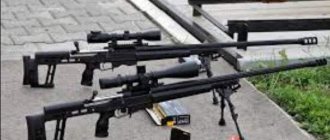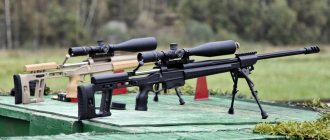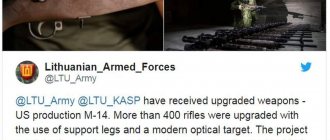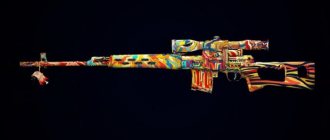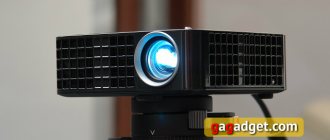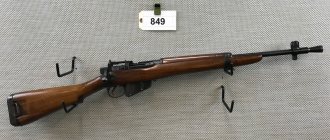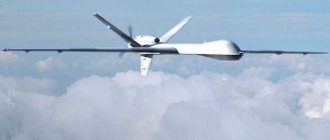This term has other meanings, see M40.
| M40 | |
| M40A3 | |
| Type | Sniper rifle |
| A country | USA |
| Service history | |
| Years of use | 1966 - present |
| Adopted | 1966 |
| In service | USMC |
| Wars and conflicts |
|
| Production history | |
| Designed by | 1966 |
| Manufacturer | Remington Custom Shop |
| Total issued | 995 (M40) |
| Characteristics | |
| Weight, kg | 4.08 (without ammo and scope) 6.57 (loaded) 7.5 (M40A3) |
| Length, mm | 1117 (M40A1) 1124 (M40A3) |
| Barrel length, mm | 660 (M40) 610 (M40A1) |
| Cartridge | 7.62x51mm NATO |
| Caliber, mm | 7,62 |
| Work principles | sliding valve |
| Initial bullet speed, m/s | 777 |
| Sighting range, m | 800m |
| Maximum range, m | 1300m |
| Type of ammunition | 5-round magazine |
| Aim | optical 10X |
| Media files on Wikimedia Commons | |
M40
- American sniper rifle, designed on the basis of the Remington 40ХВ (in turn, an improved version of the Remington 700).
The M40 is fired with 7.62x51mm NATO rifle cartridges. Technically, it is a bolt-action rifle. When firing, cartridges are supplied from a box magazine with a capacity of 5 rounds.
The rifle is equipped with a ten (10) multiple Unertl optical sight. Dispersion at a distance of 300 m is no more than 1 arc minute (5 shots are placed in a circle with a diameter of 80 mm).
MILITARY AFFAIRS there are new publications for today \\ 07/10/20
"Delayed Victory!" Marshal Vasily Ivanovich Chuikov publication No. 1593195219
June 26, 2020 Svyatoslav Martynov MILITARY MEMOIRS
Abstract from the author: I have been worried about our Victory for a long time... When, how and why... Swarming in my head... Now I can share with you! I have great faith in Marshal Chuikov! This is just a quote from the Internet. Evaluate the Selection yourself! Colleagues!!
Open full version of the publication →
O. S. NAGORNAYA. “Another military experience”: Russian prisoners of war of the First World War in Germany (1914-1922) publication No. 1588779232
May 06, 2020 Scientific Library Portalus
Abstract from the author: O. S. NAGORNAYA. "Another war experience": Russian prisoners of war of the First World War in Germany (1914-1922)
Open full version of the publication →
And the Net will rise on the fisherman publication No. 1586775878
April 13, 2020 Svyatoslav Martynov WARS AND CONFLICTS
Abstract from the author: Two thousand years have passed and everyone has learned to fish... Now our collective whaling flotilla has spread a global Net! And soon the Network itself will catch Us!
Open full version of the publication →
Water transport in the Stalingrad operation publication No. 1583391775
March 05, 2020 Scientific Library Portalus
Abstract from the author: Water transport in the Stalingrad operation
Open full version of the publication →
Formation of the Eastern Faculty of the Military Academy of the Red Army named after. M. V. Frunze publication No. 1582715196
February 26, 2020 Scientific Library Portalus
Abstract from the author: Formation of the Eastern Faculty of the Military Academy of the Red Army named after. M. V. Frunze
Open full version of the publication →
T. I. TROSHINA. The Great War and the Northern Territory: The European North of Russia during the First World War, publication No. 1582714210
February 26, 2020 Scientific Library Portalus
Abstract from the author: T. I. TROSHINA. The Great War and the Northern Territory: The European North of Russia during the First World War
Open full version of the publication →
Attempt to capture General A. A. Vlasov in 1943, publication No. 1582626082
February 25, 2020 Scientific Library Portalus
Abstract from the author: Attempt to capture General A. A. Vlasov in 1943
Open full version of the publication →
INTERNATIONAL SCIENTIFIC CONFERENCE ON THE HISTORICAL MEMORY OF THE BATTLE OF STALINGRAD publication No. 1581093443
February 07, 2020 Scientific Library Portalus
Abstract from the author: INTERNATIONAL SCIENTIFIC CONFERENCE ON THE HISTORICAL MEMORY OF THE BATTLE OF STALINGRAD
Open full version of the publication →
PRESIDENT OF THE ACADEMY OF MILITARY SCIENCES ARMY GENERAL M. A. GAREEV is 90 years old publication No. 1581093418
February 07, 2020 Scientific Library Portalus
Abstract from the author: PRESIDENT OF THE ACADEMY OF MILITARY SCIENCES ARMY GENERAL M. A. GAREEV is 90 years old
Open full version of the publication →
NORTH ATLANTIC ALLIANCE: FROM THE AGREEMENT OF INTENT TO A FULL MILITARY-POLITICAL BLOC (1949-1955) publication No. 1581068133
February 07, 2020 Scientific Library Portalus
Annotation from the author: NORTH ATLANTIC ALLIANCE: FROM AGREEMENT OF INTENT TO A FULL MILITARY-POLITICAL BLOC (1949-1955)
Open full version of the publication →
←
Next page
→
1
… 100 Publications sent to the category archive
Portalus.ru, 2004-2020
Copyright @ Scientific online library "Portalus" Place an advertisement | About Portalus | Rating | Catalog | To the authors | Search Editor-in-Chief: Pashko BB
About Portalus Rating Catalog For Authors Advertising
Story
By the mid-1980s, the M21 sniper rifles in service, created on the basis of the M14 semi-automatic rifle, began to become inoperative, and the problem of spare parts became acute. In addition, the changed situation in the world has shifted the center of the main possible operations of the US Army from Europe to the Near and Middle East. Open desert spaces dictated the requirements for accurate shooting at distances of up to 1000 meters. Not without an eye on the US Marine Corps, the Army created requirements for a new rifle, which was supposed to have a sliding bolt, a polymer stock and a stainless steel barrel. As a result of the competition, Steyr SSG69 and Remington Model 700BDL were in the finals. Remington won, and in 1987 the M24 rifle was adopted by the US Army.
New sniper rifle Mk13 Mod 7 Long Range Sniper Rifle. For US Marines
In mid-July 2020, information appeared in the American press that the US Marine Corps would soon be armed with new Mk13 Mod 7 Long Range Sniper Rifle sniper rifles, which had reached operational capability. According to the official website of the US Marine Corps, the new rifle reached full operational readiness in the second quarter of 2020. At the same time, the first Marine units received new sniper rifles back in 2020 to conduct comprehensive testing of the new weapon.
It is planned to equip reconnaissance snipers from the reconnaissance units of the American Marine Corps with the new rifle. As noted in the American press, the Mk13 Mod 7 sniper rifle is the first truly new sniper rifle to be adopted by the US Marine Corps since the Vietnam War. In the army, the new weapon should replace the M40 rifle, which was put into service back in 1966 and whose replacement has been long overdue.
The M40 sniper rifle will be replaced with the Mk13 Mod 7
Current and former snipers of the US Marine Corps units have repeatedly said that the weapons at their disposal are inferior in their tactical and technical capabilities to the sniper weapons of other American military units, and in some cases, to the weapons that are in service with the Taliban or representatives terrorist organization ISIS, banned in Russia.
So the issue of replacing M40 rifles has been brewing for quite some time and was only a matter of time. Previously, Mk13 Mod 7 rifles were already used by elite special operations forces, the so-called Navy SEALs. Now they will become available to ordinary snipers of Marine Corps units. According to Sputnik, it is planned to spend $5.3 million to replace old M40 sniper rifles with new types of sniper weapons. These rifles remained in service with the Marines for more than 50 years and were repeatedly modernized, more plastic parts appeared in their design, new sights and various removable accessories appeared. But the main limitation of the M40 sniper rifles remained their caliber .308 Win or the standard NATO cartridge 7.62x51 mm. This ammunition has limited ballistic characteristics and quickly loses energy at distances greater than 700 yards (640 meters). At the same time, the effective firing range of the M40 rifle was limited to 1000 yards (914 meters).
The new sniper rifle, which is currently known as the Mk13 Mod 7 (Long Range Sniper Rifle), is an example of a high-precision weapon that is significantly superior in its parameters to sniper rifles of previous years. The Mk13 Mod 7 rifle should replace the M40A6 model, providing US Marines with an increase in the effective range of hitting targets and increasing the lethality of the weapon. The new long-range sniper rifle will become the main weapon of sniper units and snipers of Marine Corps reconnaissance units.
Captain Nick Berger Fr.
One of the features of the Mk13 Mod 7 sniper rifle is that its bullet maintains supersonic flight speed over most of its trajectory, in this regard it is significantly superior to its predecessor, the M40A6. The Mk13 Mod 7 provides accurate sniper fire at ranges up to 1250 meters.
Most likely, the new Mk13 Mod 7 sniper rifle, like the M40A6, is built on the basis of a Remington 700 model sniper rifle equipped with a longitudinally sliding bolt (long bolt stroke). The new product features a new .300 Winchester Magnum caliber and a new high-precision barrel, which can be equipped with a suppressor from the Mk11 model. The model's features also include an adjustable stock, a bipod, and box magazines for five rounds. The delivery set includes 8 magazines, a carrying belt, a cleaning kit, a silencer and a container for transporting weapons.
The features of the new rifle also include the presence of an improved M571 daytime sniper optical sight, which features an improved reticle and provides greater magnification. The new optical sight will allow Marines to confidently identify enemies over long distances, creating a necessary safety buffer between the sniper and enemy soldiers. Many Marines who have already tested the new precision rifle note that the weapon significantly improves their shooting accuracy. In addition to improved daytime optics, the Mk13 Mod 7 sniper rifle is compatible with the AN/PVS-27 medium-range night sight.
New .300 Winchester Magnum cartridge
The main distinguishing feature of the new sniper rifle, which is going to be equipped with some units of the US Marine Corps, is a new cartridge, which provides the weapon with increased characteristics in terms of firing range and accuracy.
We are talking about the .300 Winchester Magnum ammunition (7.62x67 mm), which was created back in 1963 and was initially positioned in the USA as hunting ammunition. This cartridge used a case from a Holland & Holland hunting cartridge of the same caliber with an annular protrusion on the bottom. Taken together, the combination of a relatively light 7.62 mm bullet and a large-volume cartridge case made it possible to significantly increase the initial velocity of the bullet, which reached approximately 1000 m/s, with light versions of the bullets the speed increased even more. Such characteristics of the ammunition provided it with high flatness of flight, which is very convenient for long-range shooting, as it reduces the shooter’s work and reduces the impact of errors when incorrectly determining the range to the target. The flat, almost flat trajectory of the bullet ensured high shooting accuracy. Very soon the new product attracted the attention of not only hunters, but also the American military, who decided that the .300 Winchester Magnum cartridge was suitable ammunition for sniper rifles. The new cartridge was very useful to the American military when they needed to increase the firing range of sniper rifles in combat conditions in Afghanistan. An important advantage of the ammunition is its long direct shot range compared to other cartridges of the same caliber. Even at a firing distance of more than a kilometer, bullet dispersion in some cases does not exceed 1 arc minute, which is considered an unattainable result when firing less powerful 7.62 mm caliber cartridges. This is especially noticeable in comparison with the previous M40 Marine sniper rifle and its modifications, designed for the 7.62x51 NATO cartridge. This cartridge begins to quickly lose energy after 700 yards (640 meters). This feature requires serious training from the sniper when hitting distant targets. As experts note, a sniper has to make many adjustments when shooting. Already at a distance of 600 yards (549 meters), a sniper can expect the bullet's trajectory to drop by 105 inches (266.7 cm), and at a distance of 1000 yards (914 meters) this value will increase to 421 inches (1069 cm), which is already a very serious vertical deviation. It was the maximum effective firing range of the M40 rifles, approximately 1000 yards, that became a serious limitation for US Marines during combat operations in Afghanistan and Iraq.
7.62x51 NATO and .300 Winchester Magnum cartridges
If we talk about the new Mk13 Mod 7 sniper rifle, which is equipped with the new .300 Winchester Magnum cartridge (7.62x67 mm), then it remains effective when shooting at a distance of up to 1300 yards (1189 meters). The new high-power cartridge requires the sniper to make only 246 inches (625 cm) of vertical adjustment at 1,000 yards, while windage adjustment at the same range is limited to 40 inches (for 5 mph winds). High-power ammunition has more energy and a bullet speed of about 1000 m/s, which makes it easier to hit distant targets. The American Marines, who have already tested the new rifle, are satisfied with the new cartridge and weapon, which allow them to confidently hit the enemy at a distance of 1100-1200 meters.
Notes
- ↑ 12345
MIL-R-71126(AR) (link unavailable since 08/12/2013 [2520 days]) (English). EverySpec. — Specification MIL-R-71126 (September 24, 1992). - ↑ 12
FM 23-10. Sniper training (English). — Headquarters department of the Army. - Washington, DC, August 17, 1994. - Training Manual No. 23-10 (August 17, 1994). - Remington XM2010 repeating rifles // Master Gun magazine, No. 12 (165), December 2010. p. 6
Description
The M24 has a 609 mm long stainless steel barrel, specially treated to fire M118SB 7.62 mm NATO sniper ammunition. The barrel has a Remington-designed 5R drill, which has 5 grooves with rounded edges (to reduce friction). The rifling pitch is 1 turn per 286 mm. The butt plate is adjustable to a length of 69 mm back and forth to suit any shooter. The Leupold-Stewens M3 Ultra sight has a fixed magnification of 10x or 12x, a scale for determining the range and a compensator to take into account the decrease in the trajectory of the bullet.
The rifle is designed to use M118SB sniper cartridges. Sights are designed for the M118SB cartridge. The use of other 7.62mm NATO cartridges requires the weapon to be re-fired.
The rifle barrel is designed for 5000 shots. It is guaranteed that the accuracy of fire will not exceed the initial one by more than 2 times.
Links
- (English) . Remington Defense (Remington Arms Company). — Description of the rifle with modifications on the manufacturer’s website.
- (English) . Remington Law Enforcement (Remington Arms Company). — Description of the M24 sniper system on the website of the law enforcement department of the manufacturer.
- . Allguns.info. — Description and comparison of M24 and M40A1 (M40A1 PIP).
| Production history | |
| Constructor: | Remington Arms |
| Designed by: | 1987 |
| Years of production: | 1988 - present |
| Options: | M24A2, M24A3 |
| Characteristics | |
| Weight, kg: | 5.4 (without magazine and optical sight), 7.26 (with optical sight, carrying belt, equipped magazine) |
| Length, mm: | 1168 (with stock at minimum size) |
| Barrel length, mm: | 610 |
| Cartridge: | 7.62x51mm NATO, .300 Winchester Magnum, .338 Lapua Magnum (M24A3) |
| Work principles : | manual reloading, bolt action |
| Initial bullet speed, m/s: | 830 |
| Sighting range, m: | effective: 800 (7.62×51 mm), 1500 (.338 Lapua Magnum) |
| Type of ammunition: | fixed magazine for 5 rounds |
| Sight: | 10x42 Leupold Ultra M3A optical, detachable open |
| Images on Wikimedia Commons: | M24 SWS |
